 Okay, I was just jesting. Don't hit me yet, read on for my post dedicated to Weekend Herb Blogging this week, which is hosted by Haalo of Cook (almost) Anything At Least Once. Do also check out Kalyn's Kitchen, where WHB originated from.
Okay, I was just jesting. Don't hit me yet, read on for my post dedicated to Weekend Herb Blogging this week, which is hosted by Haalo of Cook (almost) Anything At Least Once. Do also check out Kalyn's Kitchen, where WHB originated from.

The spoonful of liquid is actually the juice from the following fruit: These blood oranges are from my neighbourhood supermarket, something unusual in a sense, since here we usually get 'exotic' fruits like raspberries and cranberries in the more 'up-market' supermarkets. So when I saw these blood oranges, into my shopping trolley they went. What's more, these are seasonal!
These blood oranges are from my neighbourhood supermarket, something unusual in a sense, since here we usually get 'exotic' fruits like raspberries and cranberries in the more 'up-market' supermarkets. So when I saw these blood oranges, into my shopping trolley they went. What's more, these are seasonal!
A comparison between these and the regular oranges.
Blood oranges are different from the regular oranges in that they contain a pigment called anthocyanin, which accounts for the deep red to purplish flesh. There are 3 types of blood oranges - Tarocco, Moro and the Sanguigno. They differ in size, the color and texture of the skin, as well as colour of the flesh. The ones I bought are pretty small, about 3/4 the size of regular oranges, has patches of red skin, though the flesh is not entirely blood red, more like uneven distribution of orange and purple.
Armed with my new recipe book Donna Hay's Modern Classics Book 2, I tried out the recipe for Lemon Curd, replacing the lemon juice with blood orange juice. After cooking, the colour of the juice 'mellowed' to a very light magenta. To serve this sweet yet slightly tangy curd, I modified the recipe(in the same book) for Macaroon Pastry cases and made some Blood Orange Curd Tartlets.

There are various other ways to use blood oranges. Use the juice for mixing cocktails and sauces, or cut into segments and dress up a salad. Or better still, make a marmalade with it for a glorious colour. Have fun experimenting while these are in season from November to about May.
Below are my modified versions of both recipes.
For tartlet base(modified from Donna Hay’s Modern Classics Book 2)
40g dessicated coconut
50g ground almond
40g fine caster sugar
1 egg white
1) Grease 14 x 2.5cm fluted tart tins*
2) Mix all the ingredients together.
3) Cover with cling wrap and refrigerate for 15 mins
4) Divide the dough into 14 pieces. Press each piece onto the bottom and up the sides of the tins.
5) Bake in a pre-heated 160C oven for 20-25 minutes or until golden brown.
6) Remove from tins, cool and fill with orange curd. If not using cases immediately, store in an air-tight container.
* The original recipe calls for 3 x 10cm tart tins with removable bases. The reason became clear when I tried to remove them from the tins. These tartlets harden very quickly once out of the oven, making them difficult to remove, despite greasing the tins. What I did was to turn off the oven once the tartlets are done, but leave the tins inside. Remove them one by one. In this way, they are still slightly soft due to the heat, making them easier to pry from the tin. But removable bases would b most ideal.
For Blood Orange Curd(modified from Donna Hay’s Modern Classics Book 2)
60ml blood orange juice
35g butter
30g sugar
1 whole egg
1 egg yolk
1) In a saucepan, heat juice and butter over low heat until butter is melted.
2) Whisk in the rest of the ingredients and over low heat, whisk continuously until mixture thickens, about 8-10 minutes.
3) Cool and refrigerate. Use to fill the pastry cases above.
* To prevent the tarts from turning soggy, it’s best to fill them just before serving.








 There is no cream used in preparing in this soup. I used potato to act as a thickening agent. The result: a smooth, thick, sweet soup chockful of veggy goodness.
There is no cream used in preparing in this soup. I used potato to act as a thickening agent. The result: a smooth, thick, sweet soup chockful of veggy goodness. This is Chilled Steamed Egg Custard. Sometimes this type of custards can have a overwhelming ‘eggy’ taste, but this does not. Instead it is very fragrant and smooth.
This is Chilled Steamed Egg Custard. Sometimes this type of custards can have a overwhelming ‘eggy’ taste, but this does not. Instead it is very fragrant and smooth. The following is a new addition to the menu. Interesting dollop of black in the middle of a white ‘ocean’.
The following is a new addition to the menu. Interesting dollop of black in the middle of a white ‘ocean’. 

 Mango pudding is commonly available, even in Singapore. Here the pudding is served with a dash of evaporated milk.
Mango pudding is commonly available, even in Singapore. Here the pudding is served with a dash of evaporated milk.
 On our last night in HK, after dinner, we were circling the Ladies Market area, looking ‘frantically’ for a shop that sells fabulous melt-in-the-mouth Tau Hua (sweet soyabean curd). We could not recall the exact location and hoped to find it based on memory. Alas, Lady Luck did not shine on us. Tired, and a little hungry from all that walking(okay, it’s just an excuse to eat), we were attracted by a dessert shop that ‘boasted’ a must-try durian cream dessert. Arh! Durian! In HK? Must-try!
On our last night in HK, after dinner, we were circling the Ladies Market area, looking ‘frantically’ for a shop that sells fabulous melt-in-the-mouth Tau Hua (sweet soyabean curd). We could not recall the exact location and hoped to find it based on memory. Alas, Lady Luck did not shine on us. Tired, and a little hungry from all that walking(okay, it’s just an excuse to eat), we were attracted by a dessert shop that ‘boasted’ a must-try durian cream dessert. Arh! Durian! In HK? Must-try! Being greedy, I also ordered the durian pastry. It consists of phyllo pastry encasing a filling of sponge cake and durian pulp. This is not bad, though I detect a faint taste of durian essence.
Being greedy, I also ordered the durian pastry. It consists of phyllo pastry encasing a filling of sponge cake and durian pulp. This is not bad, though I detect a faint taste of durian essence.
 This is called Gai Dan Zai – loosely translated as little eggs. It’s made from a pancake/waffle batter poured into a special pan and cooked.
This is called Gai Dan Zai – loosely translated as little eggs. It’s made from a pancake/waffle batter poured into a special pan and cooked. 

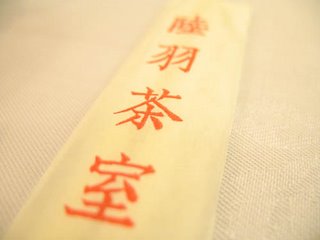

 These Har Gows (steamed prawn dumplings) are filled with prawns and minced fish, my first time seeing this combination in a Har Gow. The skin is also soft, with a slight chew.
These Har Gows (steamed prawn dumplings) are filled with prawns and minced fish, my first time seeing this combination in a Har Gow. The skin is also soft, with a slight chew.
 Make a guess what this is?
Make a guess what this is? Dessert? Pudding? Not quite. This is the first time I had Lor Bak Kow (steamed savoury radish cake) in a bowl. Most times we get it in square pieces which are lightly pan-fried on both sides. This Lor Bak Kow has minced fish in it too, together with Lap Cheong (preserved chinese sausage), which are the red pieces on top, as well as Lap Yuk (chinese waxed meat). That strand hanging off the spoon is the shredded radish.
Dessert? Pudding? Not quite. This is the first time I had Lor Bak Kow (steamed savoury radish cake) in a bowl. Most times we get it in square pieces which are lightly pan-fried on both sides. This Lor Bak Kow has minced fish in it too, together with Lap Cheong (preserved chinese sausage), which are the red pieces on top, as well as Lap Yuk (chinese waxed meat). That strand hanging off the spoon is the shredded radish. 


 These Siu Mai (steamed meat dumplings) combines chicken, prawns and fish. Topped with a bit of fish roe, it’s a meaty piece indeed.
These Siu Mai (steamed meat dumplings) combines chicken, prawns and fish. Topped with a bit of fish roe, it’s a meaty piece indeed.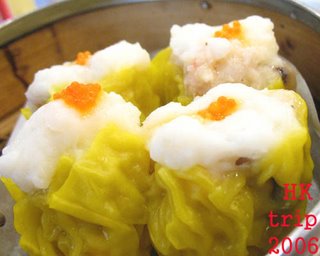

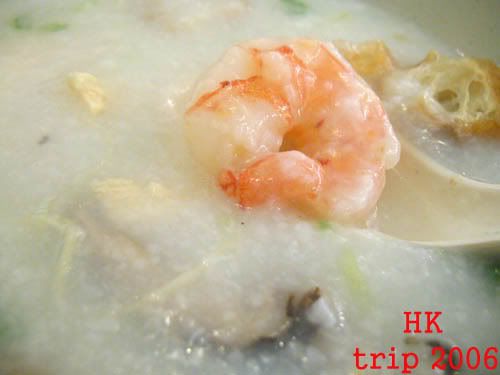 Char Siew Cheong Fun (rice rolls with roasted pork). The best cheong fun are in HK, so soft and silky smooth, unlike the local hard and dry versions. The interesting thing is, they wrap lettuce in it too, so there is rice roll, meat and vegetable in each mouthful.
Char Siew Cheong Fun (rice rolls with roasted pork). The best cheong fun are in HK, so soft and silky smooth, unlike the local hard and dry versions. The interesting thing is, they wrap lettuce in it too, so there is rice roll, meat and vegetable in each mouthful. 


 Finally we’re down to some main courses. We were just walking around aimlessly, when ‘nature called’. Since It was close to dinnertime, we decided to find a place to eat. In a nearby mall we found a restaurant named Hang Heung’s Kitchen. Hang Heung is famous for their Wife’s Biscuits(flaky pastries encasing a sweet winter melon filling), so we have confidence in this restaurant too. Judging from the steady stream of customers, it should be good, and it did not disappoint.
Finally we’re down to some main courses. We were just walking around aimlessly, when ‘nature called’. Since It was close to dinnertime, we decided to find a place to eat. In a nearby mall we found a restaurant named Hang Heung’s Kitchen. Hang Heung is famous for their Wife’s Biscuits(flaky pastries encasing a sweet winter melon filling), so we have confidence in this restaurant too. Judging from the steady stream of customers, it should be good, and it did not disappoint.
 Where are the meats, are you asking? Right here:
Where are the meats, are you asking? Right here: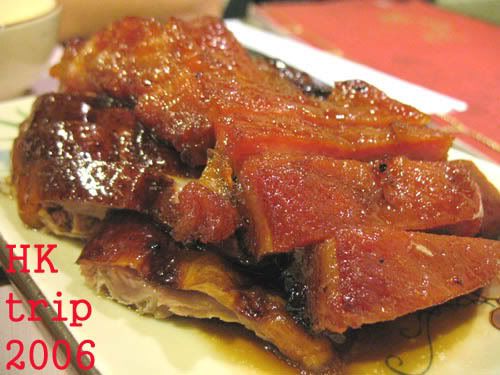
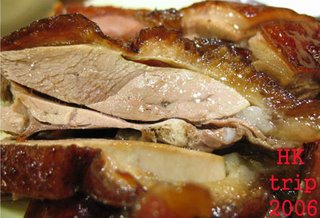
 Alright, are you full? *burp* I’m going to stop here, for you to digest these mains first. Will be back with more :p
Alright, are you full? *burp* I’m going to stop here, for you to digest these mains first. Will be back with more :p
